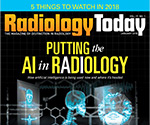 |
The current print edition of Radiology Today touches upon on an RSNA presentation showing how radiologists, with their unique ability to interpret evidence, can make a difference in the lives of those suffering from domestic abuse.
This month’s E-News Exclusive takes this principle a step farther, showing how radiologists can help when the signs indicate that a patient is suffering from a substance use disorder.
— Dave Yeager, editor |
 |
 |
Emergency Radiologists See Inner Toll of Opioid Use Disorders
Emergency radiologists are seeing a high prevalence of patients with complications related to opioid use disorders, according to results from a 12-year study presented at RSNA 2017. Researchers say the findings underscore the need for radiologists to play a role in the care continuum for these patients.
Substance use disorders of highly addictive opioids including heroin, fentanyl, and oxycodone continue to skyrocket in the United States. Intravenous opioid use disorders are a major contributor to the drug overdoses that are the leading cause of injury death in the United States, according to the Department of Health and Human Services. Patients prescribed opioid medications for pain management of a medical condition often develop dependence, and many go from crushing and injecting pills to injecting heroin as a less expensive way to deal with their disease, according to senior study author Efren J. Flores, MD, an emergency radiologist at Massachusetts General Hospital in Boston.
Full story » |
 |
 |
Growing Number of Patients Elect 3D Mammogram
According to the FDA, there are 3,915 certified mammography imaging facilities offering digital breast tomosynthesis as of January 2018. That’s a sharp increase over the previous January, when the total was 3,011, and, according to Kaiser Health News, more women are electing this new 3D option when available.
Fur Seal on Road to Recovery After MRI, Hydrocephalus Surgery
Ziggy Star still shines at Connecticut’s Mystic Aquarium. The northern fur seal made news after receiving care for a series of neurologic episodes. Mystic Aquarium’s world-class veterinary team painstakingly reviewed Ziggy’s medical records and MRI results and, finding there was some water on her brain, performed a successful surgery on the mascot, according to WNTH.
Novel PET Tracer Differentiates Bacterial Infection, Inflammation
Researchers at the University of Louisville in Kentucky have demonstrated that a new radiotracer, 2-18F-fluorodeoxysorbitol, or 18F-FDS, can identify and track bacterial infection in lungs better than current imaging methods and is able to differentiate bacterial infection from inflammation. The study is featured in the January issue of The Journal of Nuclear Medicine.
America Nearer to Breaking Ground on Domestic Medical Isotope Plant
Nuclear medicine imaging runs almost entirely on molybdenum-99, which is created in just six government-owned nuclear research reactors, none in North America, raising concerns about the reliability of the supply and prompting federal scientists to warn of the possibility of severe shortages. At the site of a former GM plant in Janesville, Wisconsin, America has taken a first step into the medical isotope business, with the first construction project to pass through the labyrinthine nuclear regulatory approval process since 1985, according to Kaiser Health News. |
 |
 |
“For patients with early-stage breast cancer, we’ve seen a significant decline in chemotherapy use over the last few years without a real change in evidence. This likely reflects a change in the culture of how physicians are practicing and a move toward using tumor biology to guide treatment choices rather than solely relying on clinical measures.”
— Allison Kurian, MD, an associate professor of medicine and of health research and policy at Stanford University School of Medicine, regarding a growing acknowledgement among oncologists that for some women, the harms of chemotherapy may outweigh its potential benefits |
 |
|
|
 |
Putting the AI in Radiology
Can deep learning enhance the synergy between man and machine? Industry luminaries ponder the ways artificial intelligence is currently being applied to radiology and the prospects they consider most fascinating. Read more »
A New Look
While 2D mammography remains the gold standard for breast screening, some say breast CT with contrast is poised to surpass it—and all of the other modalities that are presently in favor. Read more »
Surveying the Field
Traumatic brain injury continues to take a heavy toll on modern athletes. A biomedical engineer is developing innovative MRI-generated computer models that may lead to better concussion diagnoses and possibly a time-saving sideline protocol for athletes. Read more »
5 Things to Watch in 2018
RSNA offered a wealth of insights on developments in the industry. Here are several we will be keeping an eye on as the year unfolds. Read more » |
 |
|
